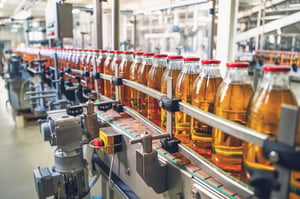 The food manufacturing industry is highly monitored and extensively regulated for good reason—the safety of everyone from end consumers to the manufacturers themselves is of utmost importance. Staying on top of the latest information and following tested procedures is vital to keeping an impeccable safety record. That’s why it helps to keep food safety guidelines on hand so all of the necessary contributors throughout the process of food manufacturing can keep them top of mind.
The food manufacturing industry is highly monitored and extensively regulated for good reason—the safety of everyone from end consumers to the manufacturers themselves is of utmost importance. Staying on top of the latest information and following tested procedures is vital to keeping an impeccable safety record. That’s why it helps to keep food safety guidelines on hand so all of the necessary contributors throughout the process of food manufacturing can keep them top of mind.
Here is a sample list of key areas where safety procedures are needed:
- Proper employee training
- Keeping machinery and equipment up-to-date
- Appropriate employee attire and personal protective equipment
- Safety features around the facility
- Cleaning processes for employees themselves as well as the equipment
Download our Food Safety Guidelines PDF here.
It also helps to be constantly monitoring the techniques and processes being used during food manufacturing. Automating steps, developing new software, purchasing equipment, and other upgrades to the process can ultimately help two-fold: by building in safeguards aligned to food safety standards and also lowering the cost and/or time in the manufacturing process. Actually, make that three-fold—in addition to lowering the cost of the process, your manufacturing company can even receive some of its financial investment in these updates back via the R&D Tax Credit.
READ: What the R&D Tax Credit Means for the Food Manufacturing Industry
The R&D Tax Credit isn’t just reserved for big tech firms or large pharmaceutical companies. Activities in a variety of industries can potentially qualify for the R&D Tax Credit regardless of business size or type—including the food manufacturing industry. Depending on the circumstances, here are some of the activities that could qualify for valuable tax benefits.
- Developing recipe formulations for new products
- Developing new flavor profiles
- Improving existing formulations to extend shelf life
- Improving existing formulations to achieve specified nutritional requirements
- Improving products and processes to meet customer demands for ingredients to be "all natural" and free of colors and dyes
- Developing new production process specifications and techniques
- Developing new processes for mixing, batching sequences, and cooking temps
- Evaluating/installing new equipment and machinery
- Developing new packaging designs to provide enhanced or increased shelf life
- Producing prototype samples for testing and validation of new recipes
- Developing small batch to large batch testing validation processes
- Sourcing raw materials to meet customer requirements for health and safety
- Finding new raw materials when political, economic or natural disasters change the availability of these important raw materials
This extensive list only calls out some of the many potential activities that can qualify for the R&D Tax Credit. To qualify, the activity must pass the Four-Part Test.
The Four-Part Test
Once you’ve identified potential qualifying activities, run it through the Four-Part Test to verify. The four parts of the test are:
- Permitted Purpose. This is the activity intended to make or improve either a product or process that results in improved function, performance, reliability, quality or cost efficiency.
- Technical Uncertainty. This is the activity intended to eliminate technical uncertainty when developing or improving a product or process related to methodology, design, techniques, formulas or inventions.
- Process of Experimentation. This is the activity that includes a process of experimentation to eliminate or resolve technical uncertainty. During the process, various alternatives and approaches are evaluated by modeling, simulation, trial and error, prototyping and other methods.
- Technological in Nature. The process of experimentation must rely on the hard sciences (engineering, physics, biology, chemistry, computer science).
Understanding how what you’re already doing—or could be doing—to improve your processes applies to the R&D Tax Credit can mean more money for your business. If you’re not sure where to start, or still have questions, we’re here to help.





